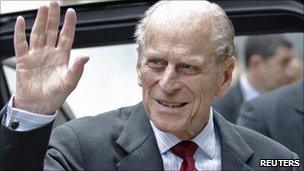Royal wedding: What do we call her?
- Published

There are suggestions Prince William wants no further ducal decoration
At the instant she and Prince William are pronounced "man and wife", Catherine Middleton will begin a new life and take on a whole new identity.
She will automatically become Her Royal Highness, Princess William of Wales.
However, she does not automatically become Princess Catherine - and certainly not Princess Kate.
The reason is very simple (if anything in this arcane area can be considered anything other than totally mystifying): Catherine Middleton is not of royal blood.
The Queen's late sister Margaret was entitled to call herself Princess Margaret. The Queen's daughter is Princess Anne and her granddaughters are Princess Beatrice and Princess Eugenie. They are, or were, of royal blood, so they are princesses in their own right.
But Sarah Ferguson was never Princess Sarah and Sophie Rhys-Jones (wife of Prince Edward) is not Princess Sophie.
And, to the astonishment of many, Lady Diana Spencer was never officially Princess Diana. She was the Princess of Wales and, after her divorce from Prince Charles, she was Diana, Princess of Wales.
Royal dukedoms
But the Royal Family has not flourished for 1,000 years or so without finding a solution to this somewhat baffling (and, perhaps, in the opinion of some, meaningless) issue of what people should be called.
It is at this point that we unfurl the banners and polish the escutcheons of the royal dukedoms.
From the palace's point of view, these are rather handy handles for the members of the family who occupy prestigious but somewhat peripheral roles to the main business of monarchy.

When he married in 1947, the future Prince Philip was created Duke of Edinburgh by King George VI
The Queen's first cousins are, respectively, the Dukes of Gloucester and Kent, and when her disgraced uncle abandoned the throne in 1936, he became the Duke of Windsor (and the more peripheral he could be made to seem the better, so far as the palace was concerned).
The point is that these ducal titles are frequently bestowed upon marriage, precisely because they give the new entrant to the family a grand-sounding title without making them princesses or princes in their own right.
For example, when Prince Andrew married Sarah Ferguson in 1986, the Queen made him Duke of York, thus she became the Duchess of York - a title she continues to hold despite her divorce and subsequent difficulties.
Similarly, when Prince Edward married Sophie Rhys-Jones, he became the Earl of Wessex and his new wife the Countess of Wessex (Edward will become Duke of Edinburgh when his father dies, and his wife the Duchess of Edinburgh, but that is another matter).
All of which brings us neatly to the one person in this puzzling issue of protocol whom you may think disproves all of the above, the Queen's husband, Prince Philip.
Aha!, it may be said, he married into the royal family - and yet he is a prince.
'Youthful glamour'
But, in point of fact, at the time Philip married the then Princess Elizabeth in 1947, the then British King, George VI, only created him "Duke of Edinburgh".
In other words, when he married the future Queen, he was not Prince Philip.
Philip had indeed been born a Prince of Greece (though he is of Danish, German, Russian and British ancestry) but he renounced his Greek titles in order to take British citizenship and marry Princess Elizabeth. At the time of his marriage he was plain Philip Mountbatten.
He only became Prince Philip in February 1957 when the Queen "accorded him the style and title of a Prince of the United Kingdom".
That precedent is interesting. It suggests the Queen could, if she chose to, make Catherine Middleton a "Princess of the United Kingdom", in which case she would genuinely become "Princess Catherine".
The alternative is for the palace to dust off a long-defunct royal dukedom (Albany, Connaught, Clarence, and Cambridge are among the vacant ones), and William and Catherine would become the Duke and Duchess of somewhere.
Will William want that? There are suggestions that he would prefer to continue to be known just as Prince William (of Wales), without any further ducal decoration.
It might be thought to be a forward-looking gesture if they did dispense with titles that many might regard as faintly Ruritanian and irrelevant and, instead, make Catherine Middleton officially a princess in her own right as Princess Catherine.
Quite apart from anything else, princes and princesses sound youthful and glamorous. Dukes and duchesses sound as though they belong in the past.
So, will the palace break with established protocol on this occasion? To do so would seem to be in tune with the times. But that may not be a sufficiently compelling reason, in the palace's eyes, to overturn centuries of tradition.